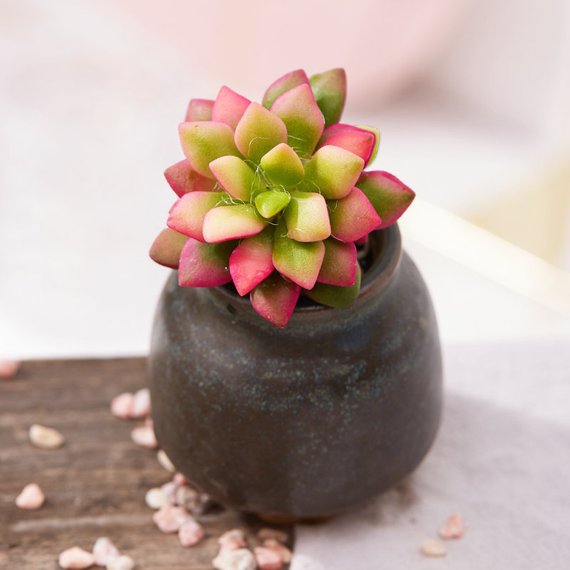Anacampseros telephiastrum Sunset has a dwarf form with slender leaves arranged like petals, and white filamentous structures growing on the branches, making it a variety with high recognizability. Here are the basic characteristics of Anacampseros telephiastrum Sunset:
Anacampseros telephiastrum Sunset is prone to branching and group growth. Its main growth period is during spring and autumn, with brief dormancy during extreme heat and cold. It thrives in temperatures between 10-30°C. With suitable soil, controlled lighting, and appropriate humidity, caring for it isn't difficult. Avoid keeping it indoors for extended periods, especially during spring and autumn when outdoor cultivation and full sunlight are preferable.
1. Suitable Soil and Shallow Potting:
Unlike other succulents with robust, woody branches and developed root systems, Anacampseros telephiastrum Sunset has slender, fleshy branches and shallow roots, requiring loose, well-aerated soil with an appropriate particle ratio.
Inappropriate soil texture, with poor aeration or excessive water retention due to a high particle ratio, can lead to root problems and subsequent wilting. Potting mixtures primarily consist of peat, with added perlite and pumice in moderate amounts, or a mix of humus, organic fertilizer, coarse sand, and a proper particle ratio of around 40%.
Due to its shallow root system, shallow potting with suitable sizes and bottom drainage holes is recommended.
2. Control Lighting and Environmental Temperature:
Anacampseros telephiastrum Sunset thrives in sunlight, and inadequate sunlight can lead to elongation and color fading of its leaves. It should be placed in bright, well-ventilated areas for daily care.
While it can endure neither high nor low temperatures well, it requires shade and protection from excessive sunlight during hot summers to prevent leaf dehydration and wrinkling. In winter, maintain relatively dry soil and an ambient temperature above 3°C to avoid frost damage.
3. Maintain Suitable Humidity:
Anacampseros telephiastrum Sunset prefers high humidity. Overwatering and high humidity can lead to elongation, leaf discoloration, root rot, and leaf drop.
Although it can withstand short periods of drought, prolonged water deficiency can cause wilting of stems and leaves. Adjust watering frequency based on soil moisture, ensuring the soil remains slightly moist.
4. Prune Appropriately and Apply Thin Fertilizer:
Spring and autumn are periods of vigorous growth for Pinus parviflora 'Shirayuki.' Prune excessive growth and weak branches to reduce nutrient consumption, promote branching, and maintain its shape.
While it can tolerate poor soil conditions, applying thin fertilizer is essential to keep its leaves plump. Avoid excessive nitrogen fertilization, as it may cause leaf discoloration. Instead, use organic fertilizer or diluted multi-element compound fertilizer once or twice a month.
Propagation:
Anacampseros telephiastrum Sunset is easy to care for and propagate. In summer, it produces attractive pink flowers, which, when successfully pollinated, may produce seed pods. However, seed propagation is relatively cumbersome and time-consuming. Stem cutting is the preferred method, where healthy top shoots and branches are dried before planting. This method is simple and has a high success rate.
1. Normal Summer Care:
Many plant enthusiasts mistakenly believe that Anacampseros telephiastrum Sunset enters a dormancy period in summer and reduce their care accordingly. However, unlike most succulents, Anacampseros telephiastrum Sunset is unique. It is highly heat-resistant and thrives during summer and autumn, even showing slight dormancy in winter.
While Anacampseros telephiastrum Sunset can endure heat, excessive exposure to direct sunlight can scorch its leaves. Partial shade is sufficient for optimal coloration. With adequate care, it will quickly recover to a healthy state.
Even when brought indoors during cold weather, the leaves may become limp. However, as long as the temperature remains above 5°C and the soil is kept slightly moist, it will resume growth once the weather warms up in spring.
2. Adequate Watering:
Although succulents are drought-tolerant, Anacampseros telephiastrum Sunset prefers moisture. If the leaves remain soft and wilted, despite watering, it may indicate root problems or soil compaction, hindering root respiration and water absorption. Repotting and inspecting the root system during warm weather can promote recovery and vigorous growth.
For bare-root Pinus parviflora 'Shirayuki,' root pruning before potting is necessary to remove dried roots. After potting, the plant may experience a period of adaptation, during which the leaves may appear soft. Keep the soil slightly moist, and new leaves will gradually emerge within about a month.
